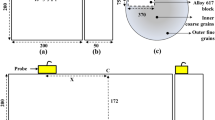Abstract
Adhesive bonding is an efficient method to join different components in structural design. However, a reliable nondestructive inspecting method to attest the integrity of adhesive bonds is still an open task. In the last few decades, many researchers have put effort into addressing this demand, and the methods based on ultrasound have emerged as the most promising ones. It is consensual that the capability of modeling both mathematically and computationally the interaction between ultrasonic waves and adhesive bonds will play a crucial role in the development of any ultrasonic inspecting method. In that sense, in a previous work, an algorithm to compute the scattering of ultrasonic waves by defective adhesive bonds was developed and implemented. In the present work, we revisit the algorithm and develop a novel GPU parallel implementation, aiming to reduce considerably the execution time. As shown, our new implementation has reduced the execution time by a factor of around 25, opening the possibility for solving the correlated inverse problem in real time. To the best of our knowledge, this is the first time in the literature that GPU is employed to solve this particular ultrasonic scattering problem.










Similar content being viewed by others
References
Aster RC, Borcher B, Thurber CH (2005) Parameter estimation and inverse problems. Elsevier Academic Press, Cambridge
Baboulin M, Dongarra J, Tomov S (2008) Some issues in dense linear algebra for multicore and special purpose architectures. In: 9th International workshop on state-of-the-art in scientific and parallel computing (PARA’08). LNCS, vol 6126–6127. Springer-Verlag
Baik JM, Thompson RB (1984) Ultrasonic scattering from imperfect interfaces: a quasi-static model. J Nondestruct Eval 4(3):177–196. https://doi.org/10.1007/BF00566223
Barrachina S, Castillo M, Igual FD, Mayo R, Quintana-Ortí ES (2008) Solving dense linear systems on graphics processors. In: Luque E, Margalef T, Benítez D (eds) Euro-Par 2008 – Parallel Processing. Euro-Par 2008. Lecture Notes in Computer Science, vol 5168. Springer, Berlin, Heidelberg. https://doi.org/10.1007/978-3-540-85451-7_79
Buttari A, Langou J, Kurzak J, Dongarra J (2009) A class of parallel tiled linear algebra algorithms for multicore architectures. Parallel Comput 35(1):38–53. https://doi.org/10.1016/j.parco.2008.10.002
Castaings M, Siryabe E, Rénier M, Meziane A, Galy J (2015) Ultrasonic characterization of cohesive and adhesive properties of adhesive bonds. J Acoust Soc Am 138:1766–1766. https://doi.org/10.1121/1.4933583
Fan Z, Castaings M, Lowe M, Biateau C, Fromme P (2013) Feature-guided waves for monitoring adhesive shear modulus in bonded stiffeners. NDT & E Int 54:96–102. https://doi.org/10.1016/j.ndteint.2012.12.006
Haidar A, Abdelfatah A, Tomov S, Dongarra J (2017) High-performance cholesky factorization for gpu-only execution. In: Proceedings of the General Purpose GPUs (GPGPU-10). Association for Computing Machinery, New York, NY, pp 42–52. https://doi.org/10.1145/3038228.3038237
Ju T, Achenbach JD, Jacobs LJ, Qu J (2019) Nondestructive evaluation of thermal aging of adhesive joints by using a nonlinear wave mixing technique. NDT & E Int 103:62–67. https://doi.org/10.1016/j.ndteint.2019.02.006
Leiderman R, Barbone PE, Braga AMB (2007) Reconstructing the adhesion stiffness distribution in a laminated elastic plate: exact and approximate inverse scattering solutions. J Acoust Soc Am 122(4):1906–1916. https://doi.org/10.1121/1.2772212
Leiderman R, Braga AMB, Barbone PE (2005) Scattering of ultrasonic waves by defective adhesion interfaces in submerged laminated plates. J Acoust Soc Am 118(4):2154–2166. https://doi.org/10.1121/1.2036147
Leiderman R, Castello DA (2014) Scattering of ultrasonic waves by heterogeneous interfaces: formulating the direct scattering problem as a least-squares problem. J Acoust Soc Am 135(1):5–16. https://doi.org/10.1121/1.4845615
Leiderman R, Castello DA (2016) Detecting and classifying interfacial defects by inverse ultrasound scattering analysis. Wave Motion 65:119–129. https://doi.org/10.1016/j.wavemoti.2016.04.008
Leiderman R, Junqueira BF, Castello DA, Braga AMB (2018) Identifying the ultrasonic inspecting fields that most strongly interact with adhesive bonding defects. J Braz Soc Mech Sci Eng 40(4):227. https://doi.org/10.1007/s40430-018-1151-3
Liu T, Pei C, Cheng X, Zhou H, Xiao P, Chen Z (2018) Adhesive debonding inspection with a small emat in resonant mode. NDT & E Int 98:110–116. https://doi.org/10.1016/j.ndteint.2018.05.005
Nakagawa S, Nihei KT, Myer LR (2004) Plane wave solution for elastic wave scattering by a heterogeneous fracture. J Acoust Soc Am 115(6):2761–2772. https://doi.org/10.1121/1.1739483
Rokhlin SI, Huang W (1992) Ultrasonic wave interaction with a thin anisotropic layer between two anisotropic solids: exact and asymptotic-boundary-condition methods. J Acoust Soc Am 92(3):1729–1742. https://doi.org/10.1121/1.403912
Thomas R, Drinkwater BW, Liaptsis D (2005) The reflection of ultrasound from partially contacting rough surfaces. J Acoust Soc Am 117(2):638–645. https://doi.org/10.1121/1.1835505
Yan D, Neild SA, Drinkwater BW (2012) Modelling and measurement of the nonlinear behaviour of kissing bonds in adhesive joints. NDT & E Int 47:18–25. https://doi.org/10.1016/j.ndteint.2011.12.003
Yu X, Fan Z, Castaings M, Biateau C (2017) Feature guided wave inspection of bond line defects between a stiffener and a composite plate. NDT & E Int 89:44–55. https://doi.org/10.1016/j.ndteint.2017.03.008
Acknowledgements
The authors acknowledge the support of the Brazilian research agencies CNPq and CAPES.
Author information
Authors and Affiliations
Corresponding author
Ethics declarations
Conflicts of interest
The authors declare that they have no conflict of interest.
Additional information
Technical Editor: José Roberto de França Arruda.
Publisher's Note
Springer Nature remains neutral with regard to jurisdictional claims in published maps and institutional affiliations.
Rights and permissions
About this article
Cite this article
de Castro Ribeiro, M., Leiderman, R. & Clua, E.W.G. Toward an ultrasonic inspecting method to detect and classify adhesive bonding defects in real time: a numeric study. J Braz. Soc. Mech. Sci. Eng. 42, 240 (2020). https://doi.org/10.1007/s40430-020-02315-4
Received:
Accepted:
Published:
DOI: https://doi.org/10.1007/s40430-020-02315-4



